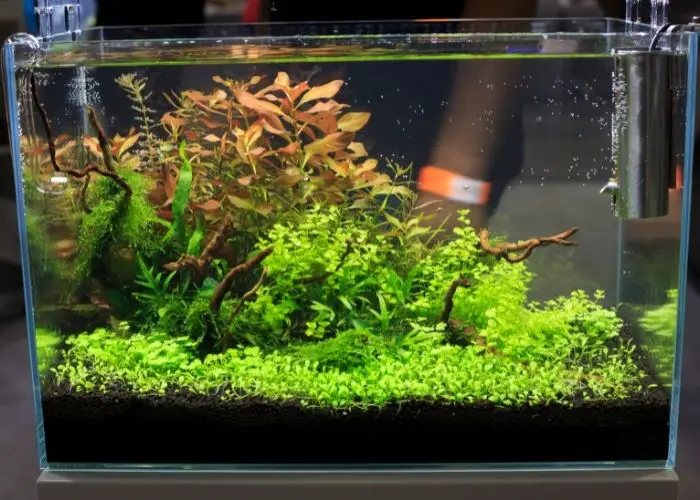Last Updated on January 23, 2022 by Fabiola L.
If you are an aquaponics expert, you know the importance of cycling your tank. This is why we created this article to teach you how to cycle a tank in 24 hours!
Cycling a fish tank is when you force your tank’s water to undergo the nitrogen cycle in order to clear the tank from harmful nitrites and ammonium. There are many different approaches to doing it.
Some people cycle their tank with the fish inside, while others do it without. Cycling your tank is crucial to keeping your ecosystem balanced. If nitrite and ammonia levels get too high, your fish will be unable to perform crucial functions for their survival.
This means that your fish will die! It is best to do your cycling prior to adding the fish to your tank. Cycling helps establish the proper bacteria that will consume nitrates and ammonia and convert them to harmless nitrates.
You need to understand the nitrogen cycle to know what we are talking about. In order to have an aquaponics system, you always need to keep an eye on the nitrogen cycle. This means that you have to consistently test your tank’s water to understand what is going on in the ecosystem.
Often, this cycling process can take between 1-2 months to establish a healthy amount of bacteria. However, we have written this article to teach you to cycle a tank in only 24 hours!
Keep reading to learn more.
How To Cycle A Tank Fast?
One of the keys to success in how to cycle a tank in 24 hours, is having a properly balanced ecosystem and tank set up. This means that all parts of your tank are already in place. Make sure you have your filters, heaters, pumps, and piping all in place before starting your cycling.
The beneficial bacteria established in cycling likes to stick to surfaces of your filter and tank. Without these things, there will be less surfaces for it to cling to and grow. Bacteria will specifically like to grow on your filter!
This is super useful because once the bacteria colonies are established in your filter, they will continue to eat harmful nitrites as water passes through.
Another thing to help speed up your cycle is the use of a tank heater. Tank heaters are typically used to keep water at higher temperatures because your specific fish require a hotter climate to thrive. This is commonly seen in tropical fish tanks.
When it comes to tank cycling, the heater is very useful because bacterias like to grow at higher temperatures. By using the heater, you can stimulate the growth rates to be faster. The most optimum temperature range for beneficial bacteria growth is between 65- 85 degrees Fahrenheit.
Whenever doing a cycle, make sure to keep it in this range. Anything outside of this temperature will slow the growth rate. Use a thermometer to take exact measurements of your temperature.
The next aspect to pay attention to is your PH level. According to New Mexico State University, the PH level of your water heavily determines the amount of Ammonia and Nitrate that your system can handle. Not only does the PH affect the actual amounts of ammonia and nitrites, but also the rate of bacterial growth.
The most important thing is to keep your PH level above 7. Anything below 7 will make it very difficult for the bacteria to grow and thrive. You can purchase PH test kits and take measurements on a weekly basis.
Keeping your PH in check is the key to a healthy fish tank ecosystem. Never skip this step.
The Fastest Way To Cycle A Tank
Once you have those aspects established properly, you are ready to begin your cycling process. When you are ready, start by turning on your pump and filter system. This should remain on throughout the whole process!
The bacteria needs oxygen to survive, and when water passes through the filter, it takes up oxygen from the air. Keeping your filter on, will ensure that there is an adequate amount of oxygen available for your bacteria.
Secondly, make sure to test your tap water. Many city systems add chlorine to their water. Chlorine is absolutely detrimental to your fish tank and cycling process. First off, chlorine is not good for fish to live in.
But second off, and perhaps more importantly, the chlorine will kill beneficial bacteria. Be sure to dechlorinate your tap water every time you add new water to your tank.
You can buy water conditioning tablets from your local pet store. Process the tap water before adding it to your tank.
Another great trick to speed up your cycling system is to take some water from another tank which is already established. An existing healthy tank will already have lots of beneficial bacteria in it. Adding it into your new tank will kickstart this process.
If you have trouble finding another tank, ask around at your pet store. Someone should be happy to help!
The best way to do this is to actually take a used filter containing the bacteria from another tank.
Other Ways To Instant Cycle Freshwater
If you cannot find this, you can buy special nitrifying bacteria from stores. Be sure to buy the right product, though. Some of the products are only for temporary use to kill nitrites and ammonia when you have a problem.
Others contain the bacteria that actually will establish and grow in your tank. One good brand to use is called Tetra Safestart.
If you keep all the above-mentioned conditions, you will be able to cycle your tank much faster than the average time. The most important thing is to buy a nitrite and ammonia test kit to monitor your levels. This is how you will know that the cycling is successful and that you can add fish to your tank.
Hopefully, now you learned how to cycle a tank in 24 hours. While it is a detailed process, it’s crucial to your tank ecosystem.
Feel free to comment and ask questions below!
How to cycle a tank fast?
One of the keys to success in cycling your tank fast, is having a properly balanced ecosystem and tank set up. This means that all parts of your tank are already in place. Make sure you have your filters, heaters, pumps, and piping all in place before starting your cycling.

Candace is an aquaponics expert with over 5 years of experience in the field. She has a degree in environmental science from the University of California, Berkeley and a degree in aquaponics from the University of Florida. She is passionate about sustainable agriculture and has a deep knowledge of aquaculture and hydroponics. She has worked on numerous projects and has been involved in the development of aquaponic systems and fish farms. She also has experience in designing and constructing aquaponic systems. With her expertise, Candace is able to advise clients on the most effective and efficient way to construct and manage their aquaponic system. She is an active member of the aquaponic community, often speaking at conferences and seminars. Candace is dedicated to helping others understand the importance of aquaponics, and she is a strong advocate for sustainable food production.

